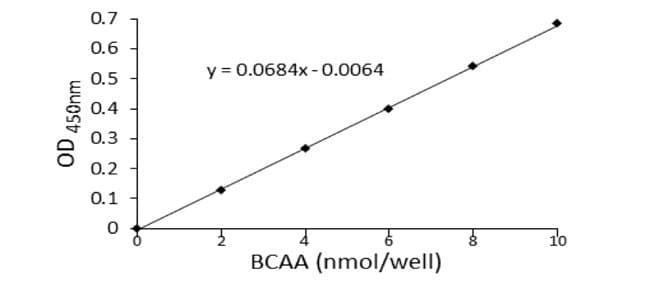Enzymatic Method for Determining Branched Chain Amino Acids (BCAA Assay)
This assay protocol is suitable for the colorimetric detection of branched-chain amino acids, leucine, isoleucine, and valine, in cell and tissue culture supernatants, urine, plasma, serum, and other biological samples using the Branched Chain Amino Acid Kit (MAK003). BCAA concentration is determined by a coupled enzyme assay, which results in a colorimetric (450 nm) product, proportional to the BCAA present. The linear range of detection for this assay is between 2–10 nmole.
Precautions and Disclaimer
This product is for R&D use only, not for drug, household, or other uses. Please consult the Safety Data Sheet for information regarding hazards and safe handling practices.
Reagents
- BCAA Assay Buffer (MAK003A) – 25 mL
- BCAA Enzyme Mix (MAK003B) – 1 vl
- WST Substrate Mix (MAK003C) – 1 vl
- Leucine Standard, 1 μmole (MAK003D) – 0.1 mL
Reagents and Equipment Required but Not Provided
96 well flat-bottom plate – It is recommended to use clear plates for colorimetric assays (Catalog Number M4436 or equivalent).
Spectrophotometric multiwell plate reader
Preparation Instructions
Briefly centrifuge vials before opening. Use ultrapure water for the preparation of reagents. To maintain reagent integrity, avoid repeated freeze/thaw cycles.
BCAA Assay Buffer – Allow buffer to come to room temperature before use.
BCAA Enzyme Mix - Reconstitute with 220 μL of BCAA Assay Buffer. Mix well by pipetting, then aliquot and store, protected from light, at 2–8 °C. Use within 2 months of reconstitution and keep cold while in use.
WST Substrate Mix - Reconstitute with 220 μL of water. Mix well by pipetting, then aliquot and store, protected from light, at 2–8 °C. Use within 2 months of reconstitution and keep cold while in use.
Leucine Standard- Ready-to-use as supplied. Store at 2–8 °C.
Storage/Stability
The kit is shipped on wet ice. Storage at –20 °C, protected from light, is recommended.
Procedure
All samples and standards should be run in duplicate.
Procedure
Leucine Standards for Colorimetric Detection
Dilute 10 μL of the 1 μmole (10 mM) Leucine Standard with 90 μL of water to generate a 1 mM standard solution. Add 0, 2, 4, 6, 8, and 10 mL of the 1 mM standard solution into a 96 well plate to generate 0, 2, 4, 6, 8, and 10 nmole/well standards. Add BCAA Buffer to each well to bring the volume to 50 μL.
Sample Preparation
Tissue (10 mg) or cells (2 x 106) should be rapidly homogenized in 100 μL of cold BCAA Assay buffer. Centrifuge at 13,000 x g for 10 minutes at 4 °C to remove insoluble material.
Serum and other liquid samples can be directly added to the wells.
Bring samples to a final volume of 50 μL with BCAA Assay Buffer.
For unknown samples, it is suggested to test several sample dilutions to ensure the readings are within the linear range of the standard curve.
Note: NADH or NADPH from cell or tissue extracts generates background for this assay. To remove the effect of NADH or NADPH background, a blank may be set up for each sample by omitting the BCAA Enzyme Mix. The blank readings can then be subtracted from the sample and standard readings.
Assay Reaction
1. Set up the Reaction Mixes according to the scheme in Table 1. 50 μL of the appropriate Reaction Mix is required for each reaction (well).
2. Add 50 μL of the appropriate Reaction Mix to each of the wells. Mix well using a horizontal shaker or by pipetting, and incubate the reaction for 30 minutes at room temperature. Protect the plate from light during the incubation.
3. Measure the absorbance at 450 nm (A450).
Results
Calculations
The background for the assays is the value obtained for the 0 (blank) Leucine Standard. Correct for the background by subtracting the 0 (blank) value from all readings. Background values can be significant and must be subtracted from all readings. Use the values obtained from the appropriate Leucine standards to plot a standard curve.
Note: A new standard curve must be set up each time the assay is run.
Subtract the blank sample value from the sample readings to obtain the corrected measurement. Using the corrected measurements, determine the amount of BCAA present in the sample from the standard curve.
Concentration of BCAA
Sa/Sv = C
Sa = Amount of BCAA in unknown sample (nmole) from standard curve
Sv = Sample volume (mL) added into the wells
C = Concentration of BCAA in sample
Sample Calculation
Amount of BCAA (Sa) = 5.84 nmole
(from standard curve)
Sample volume (Sv) = 50 μL
Concentration of BCAA in sample
5.84 nmole/50 μL = 0.1168 nmole/μL

Figure 1.Mak Standard Curve
Materials
To continue reading please sign in or create an account.
Don't Have An Account?